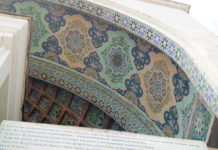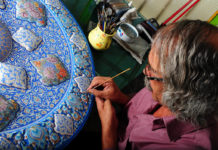Thangka, also spelt as thang-ga or thanka, refers to a religious scroll painting framed with colored silk and displayed on wall for worship. Thangka is a characteristic form of painting art in Tibetan culture, involving various fields of Tibetan culture such as its history, politics, culture and social life, yet the most common theme is Buddhist deity.
Thangka is usually painted on cloth and paper, in addition to more than ten types of material such as pearl, colored painting, embroidery, brocade, silk tapestry, jacquard, silk appliqué and gem decorated thangkas. The main pigments used for colored thangka are mineral pigments such as gold powder, silver powder, cinnabar and realgar, supplemented by organic pigments in some cases. Embroidered thangka is made of colorful silk threads and features landscapes, figures, flowers, feathers, pavilions and building. “Piled embroidery” is a brocade thangka that is woven by incorporating the design into the weave with satin as the background and colorful threads as the weft, and then glued to the fabric. Silk appliqué thangka is made of colorful silk which was cut into various figures and patterns and glued to the fabric. Finally, silk tapestry thangka is produced by the method of “connecting the warp while cutting the weft” to make it highly decorative with a colorful weft.
A thangka is usually shaped as a vertical rectangle. The central part of the painting is named as “Meilong”, the core of a thangka. Thangka is usually framed with yellow and red silk, which is called rainbow. And a square piece of silk of a different color will be framed in the middle of the lower side. Thangka is incorporated with a stem in the upper side and a scroll in the lower side. Silk of the lower part of the painting slightly appears in the shape of trapezoid with red or white lines incorporated along the edges of the silk. The scroll is decorated with pure silver, ivory, jade or bronze ends on either side with dragon patterns, etc., carved on the scroll, reflecting exquisite craftsmanship. A flexible silk cover is placed on the front of the painting for protection, with two equally long threads on the silk cover. The painting is normally covered by the silk, which will be rolled up when on display.
A high-quality thangka is painted with more than 30 colors—even 40 to 50 colors in some cases. Red, yellow, white, black, green, blue, purple and light blue are the basic colors which are frequently seen in a thangka. All pigments are natural mineral and organic materials, which are very resplendent and durable, reflecting rich Tibetan style.
When painting a thangka, the artist should follow strict requirements and extremely complicated procedures, so he must be in accordance with guidelines laid out in Buddhist scripture and requirements of guru during the whole painting process. This includes pre-ceremony, making painting cloth, drafting, coloring and dying, sketching and fixing, gold and silver power spreading, eye drawing and framing, and consecration. It takes comparatively long time to make a thangka—half a year at the minimum and more than a decade at the maximum.
In China, thangka painting is mainly concentrated in Tibet, Qinghai, Sichuan, etc. There are a few but not many national masters in this area who are still alive, including Deng Du, Gesang Cidan, Gengdeng Daji, Xi Hedao, Dou Ga and Niang Ben.





